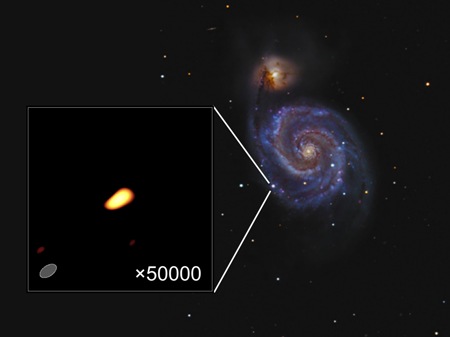Astronomers have used radio interferometry to obtain a radio astronomical photograph of a cosmic explosion, the youngest supernova SN2011dh, just 14 days after a star exploded in the Galàxia del Remolí (M51) galaxy last June. The international astronomer team coordinated telescopes around Europe to achieve this feat.
 The Galaxy and the supernova SN2001dh through a telescope. In the extension, image of SN2001dh captured by a European network of radio telescopes on 14 June, two weeks after its explosion. © Optical image (right): Rod Pommier 2011, Pommier Observatory, Portland, OR, USA. Radio image: I. Martí-Vidal and colleagues, Astronomy & Astrophysics, 2011.
The Galaxy and the supernova SN2001dh through a telescope. In the extension, image of SN2001dh captured by a European network of radio telescopes on 14 June, two weeks after its explosion. © Optical image (right): Rod Pommier 2011, Pommier Observatory, Portland, OR, USA. Radio image: I. Martí-Vidal and colleagues, Astronomy & Astrophysics, 2011.
Galàxia El Remolí in the constellation of Llebrers is at around 23 million light years from the Earth. The death of a star in the form of a supernova explosion in this galaxy is considered to be one of the most violent phenomenon that has ever occurred in the universe. Though, the explosion by itself is beautiful.
The Institute of Astrophysics of Andalusia and the University of Valencia took part in this study. The National Geographic Institute in Yebes, Guadalajara and the NASA’s telescopes at Robledo de Chavela in Madrid took part in the research. Other telescopes located in Finland, Germany, and Sweden also participated. The combined data was processed by a supercomputer located in The Netherlands. The spread of the telescopes enabled a telescope having the capacity of thousands of kilometers. The detail obtained was over 100 times greater than that obtainable by the Hubble space telescope.
Iván Martí belonging to the Institut Max Planck of Radio Astronomy in Bonn, stated that this was the earliest high resolution supernova explosion image. Jon Marcaid, a professor in Astronomy and Astrophysics at the University of Valencia, said that with this kind of accuracy, looking for previous stars in earlier galaxy photographs can be possible. Antxon Alberdi of the Institute of Astrophysics of Andalusia, stated that the Very Long Baseline Interferometry technique can help obtain clear, high resolution images of supernovas. Iván Martí Vidal of the University of Valencia led the international research team.
The photograph of the explosion has been taken with detail equivalent to that of viewing a golf ball on the moon’s surface. The results of the study are to be published in the Astronomy & Astrophysics journal.